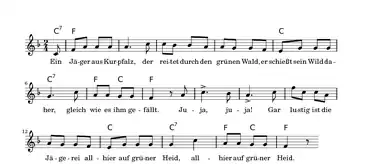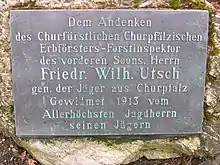
Ein Jäger aus Kurpfalz ("A Hunter from the Palatinate") is a German folk song. It celebrates a hunter freely riding across the land and hunting, and is traditionally associated with the Soonwald forest and the Hunsrück uplands of the Palatinate (Kurpfalz). The later stanzas feature somewhat crude sexual exploits of the hunter; modern songbooks, especially those used by children, usually remove stanzas 3, 4, and 5. The base melody has been used and remixed in a variety of ways, from military marches to pleasant public event themes.
Creation
Both the author of the lyrics and the composer of the melody are unknown. The earliest known written reference to the song is from 1794, but music historians have speculated the song was created earlier than that and passed around orally and informally. Ludwig Erk suggested the song was created in 1763; Franz Magnus Böhme speculated it came from even earlier, at the dawn of the 18th century during the cultural height of German hunting. The modern form of the melody was written by Leo von Seckendorf in the 1808 book Musenalmanach für das Jahr 1808.[1]
Identity of the hunter

_Karl_Theodor.jpg.webp)
Various people have been suggested to be the hunter that is the subject of the song. One common guess is Friedrich Wilhelm Utsch, head-forester for the Bishop of Mainz in the Soonwald in the 18th century. In the tradition that suggests Utsch was the subject, the original creator of the lyrics was Martinus Klein, a Carmelite friar. Another proposal is John Casimir of the Palatinate-Simmern (German: Johann Kasimir), although this would imply a very early date for the creation of the song as John Casimir lived in the 16th century. Other prospects include Johann Adam Melsheimer, who served as forester of the Soonwald from 1719 to 1757 before Utsch, and Charles Theodore, Elector of Bavaria (German: Karl Theodor), who was Count Palatine of the Rhine from 1777–1799 and was known to both enjoy hunting and to have fathered a number of extramarital children. Charles Theodore was also a member of the Order of Saint Hubert, which would fit with the "Hubertus" lyric in the third stanza; Hubertus was the patron saint of hunting.[2][3][4][5][6]
Lyrics
1. Ein Jäger aus Kurpfalz, |
A hunter of Kurpfalz |
The references to the cuckoo in stanza 6 are referring to the baby's cry as a result of the hunter's affair in stanzas 3–5; in variants that cut those stanzas, it is just an abstract event that will never happen, meaning the hunter will stay hunting.
Adaptations and appearances
- The tune is well-known, and other songs have been written with new lyrics that often reference or parody the original lyrics. The 1844 song "Das erwachte Bewusstsein" ("The Awoken Consciousness") by August Heinrich Hoffmann von Fallersleben is set to the melody of "Kurpfalz". It jokingly references the political turbulence of the era that would lead to the German revolutions of 1848–1849, with a refrain that mockingly celebrates the happiness of the government that has citizens who sit around doing nothing at pubs (instead of celebrating hunting).[7][8]
- Karl Immermann wrote the novel Der Oberhof in 1840, a novel set in Westphalia in the Palatinate. The novel was eventually adapted by Victor Hollaender into Der Jäger aus Kurpfalz, a folk operetta in three acts that premiered on April 2, 1919.[9]
- The 1925 opera Wozzeck by Alban Berg includes the song in a tavern scene.[10]
- A minor 1933 German film, The Hunter from Kurpfalz, is loosely based on the story.[11]
- The comedian Loriot drew an exaggerated version of the Hunter from Kurpfalz as a mascot for the 1975 Bundesgartenschau (Bundesgartenschau 1975), a horticulture show.[12]
- The politician Helmut Kohl played the song as a theme song at many of his public events, such as while campaigning or performing town halls. Kohl came from Ludwigshafen in Rhineland-Palatinate, the modern West German state to the old Electorate of the Palatinate.[13]
- The song appears in the 2017 video game Civilization VI.
References
- ↑ Ludwig Erk, Franz Magnus Böhme (Hrsg.): Deutscher Liederhort. Band 3. Leipzig 1893–94 (Nachdruck: Olms, Hildesheim 1963), S. 315 (Digitalisat).
- ↑ Historie von Auen: Friedrich Wilhelm Utsch, genannt der Jäger aus Kurpfalz at the Wayback Machine (archived July 18, 2011)
- ↑ Spall Soonwald − Der Jäger aus Kurpfalz
- ↑ Widmaier, Tobias. Ein Jäger aus Kurpfalz.
- ↑ Karl Scherer: Pfalzgraf Johann Casimir (1543–1592) und das Volkslied „Ein Jäger aus Kurpfalz". In: Werner Kremp (Hrsg.): The Huntsman from Kurpfalz. Über den Zusammenstoß und die Zusammenarbeit von deutscher und amerikanischer Jagdkultur. Wissenschaftlicher Verlag Trier, Trier 2002, ISBN 3-88476-559-0, S. 29–64.
- ↑ Xaver Frühbeis: Utsch oder nicht Utsch: Der Jäger aus Kurpfalz. BR4-Klassik Mittagsmusik extra 27 December 2012
- ↑ John, Eckhard; Robb, David (2020). Songs for a Revolution: The 1848 Protest Song Tradition in Germany. Rochester, NY: Camden House. p. 323. ISBN 9781640140486.
- ↑ Bei einer Pfeif Tabak (Das erwachte Bewußtsein)
- ↑ Der Jäger aus Kurpfalz : Volksstück mit Gesang in drei Akten
- ↑ Zijlstra, Miep. "Jachtmuziek". Algemene Muziek Encyclopedie, 1981, Vol. 5.
- ↑ "Der Jäger aus Kurpfalz". Filmportal.de. Retrieved November 3, 2012.
- ↑ "Jäger aus Kurpfalz" war 1975 das heimliche Logo der Mannheimer Bundesgartenschau. July 1, 2020.
- ↑ Der große Zapfenstreich. Gespräch mit Oberstleutnant Heiner Bröckermann vom Militärgeschichtlichen Forschungsamt in Potsdam. DRadio Wissen 10 March 2011, retrieved 2 April 2011.
External links
- Ein Jäger aus Kurpfalz
- Ein Jäger aus Kurpfalz im Liederprojekt von Carus-Verlag und SWR2.